THE UC HIVE NOV 2023
San Francisco de la Sierra, BCS
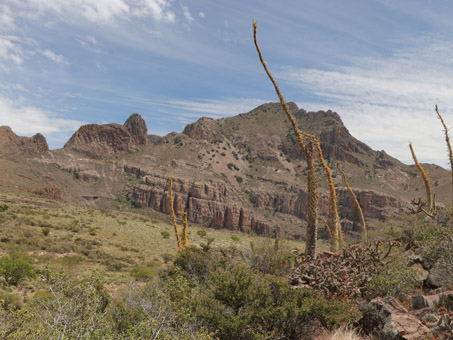 April 2023 — While we didn't reprise last April's trip to the rock art at Santa Martha and Cueva el Palmarito, my friends and I did make a trip to the same general area. This time, however, we stayed two nights at the Ecolodge at Volcán las Tres Vírgenes and made two day trips by car (no mules for us!) to botanize, one to explore the area around the volcano and another to Rancho San Francisco de la Sierra. See the map below (Image source: Google Earth).
April 2023 — While we didn't reprise last April's trip to the rock art at Santa Martha and Cueva el Palmarito, my friends and I did make a trip to the same general area. This time, however, we stayed two nights at the Ecolodge at Volcán las Tres Vírgenes and made two day trips by car (no mules for us!) to botanize, one to explore the area around the volcano and another to Rancho San Francisco de la Sierra. See the map below (Image source: Google Earth).
Amazingly, this small village (located in the central Sierra de San Francisco) and Santa Martha are only about 5 miles apart as the crow flies, but about 3-4 hours by road (via the transpeninsular highway and dirt road) or around 6 hours by mule up the canyon and over the mountain range that lies between them.
We missed out on much of the lush early spring bloom in the Vizcaíno Desert common in February to March, but there was still much to see, as well as many plants just starting to bloom in the Sierras.
From the turnoff at Km 116 S of the town of Vizcaino on the transpeninsular highway, over about 36 km the road climbs from about 75 m to around 1170 m above sea level at the Rancho.
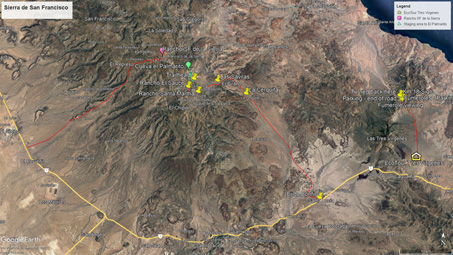 We made our first trip to the Sierra de San Francisco way back in May 2007 and was that ever an adventure. We stayed two nights at the hostel at the tail-end of a late spring storm and almost froze overnight, the frigid wind filtering through the cracks in the stone building and palm thatched roof. Even our cat was miserably cold and slept inside my sleeping bag.
We made our first trip to the Sierra de San Francisco way back in May 2007 and was that ever an adventure. We stayed two nights at the hostel at the tail-end of a late spring storm and almost froze overnight, the frigid wind filtering through the cracks in the stone building and palm thatched roof. Even our cat was miserably cold and slept inside my sleeping bag.
During the day in order to stay warm, I wandered around looking at all the unfamiliar plants or sat in the kitchen drinking hot tea and munching on fresh tortillas right off the griddle while chatting with the young couple (Chico and Yadira) in charge of the hostel.
When I mentioned my interest in plants, Chico's eyes lit up and he took me outside and showed me around the area, pointing out all of the common local plants and teaching me the names they used. He also showed me a number of plants that they wanted to learn about. We collected small samples of everything we had looked at and I took photos and copious notes, then promised to find out more about each of the unknown plants and at his request, to create a short plant guide for them to show the clients they took on mule trips to the rock art sites. Later that year, I self published a limited bilingual edition of The Plants of Sierra San Francisco/Las Plantas de la Sierra San de Francisco and delivered copies of it to them the following year.
Since that visit, we've been back to visit a couple more times, and each time it had been unseasonably cold. So, now we were off again, heading up into the Sierra de San Francisco on what would turn out to be a lovely spring day. So, read on... And for a full list of this month's plants (with family, Latin name and common names in both English and Spanish), visit this page.
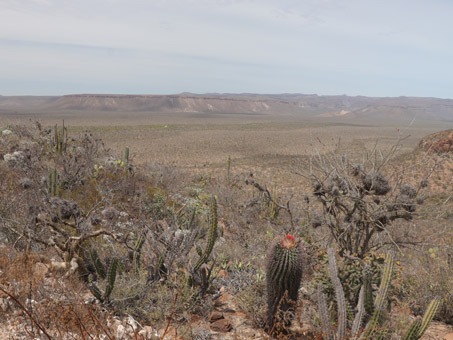
View to the NE from a fingerlike mesa just near the W edge of the sierras. You may recognize some cacti: Cylindropuntia, Ferocactus, Stenocereus & Pachycereus. There´s also a Fouquieria diguetii.
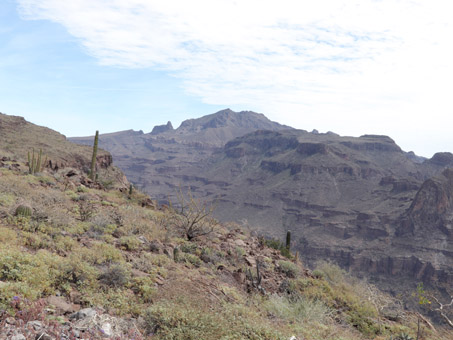
Still climbing along the mesa. Great views far down into the canyon. On our 2007 trip, the road here was still dirt and it sure felt like the canyon dropped off just beyond the edge on either side.
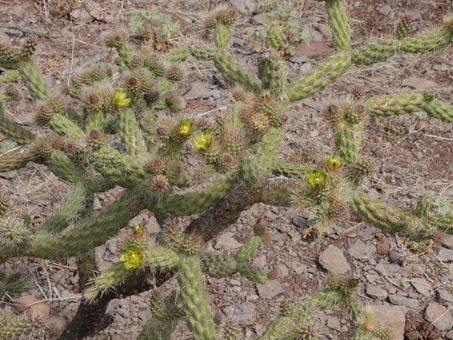
There were so many chollas on the mesa! This is Peninsular Cholla / Clavellina (Cylindropuntia alcahes var. alcahes). The species is so variable. This one had flowers with clear yellow perianth segments.

The spines on some ovaries were just slightly reddish. These flowers had the slightest tinge of red.
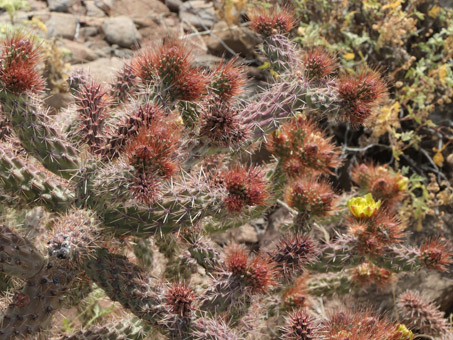
Then there were plants like this with very furry, reddish brown ovaries but mostly clear yellow flowers.
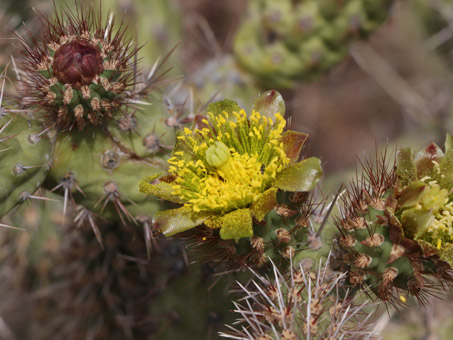
Here we have ovaries with few reddish spines and flowers with green perianth segments.
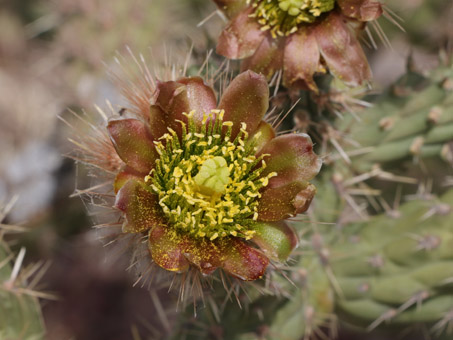
And sparsely spiny ovaries with tan spines & perianths more reddish.

And perianths mostly red inside & out with a few red spines. Oy vey!
We saw two endemic species of Barrel Cactus within a short distance of each other. Some individuals were tiny, others very tall and some tall and squat. The Peninsular Barrel is common from around Bahia de los Angeles to the Magdalena Plain and the Long-spine Barrel is endemic from the the Sierra de San Francisco southward through the Sierra la Giganta (occurs from sea level to the mountains).

Peninsular Barrel Cactus / Biznaga (Ferocactus peninsulae var. peninsulae). None were blooming. Flower segments are orange with a red midstripe. This individual was about 60 cm tall.
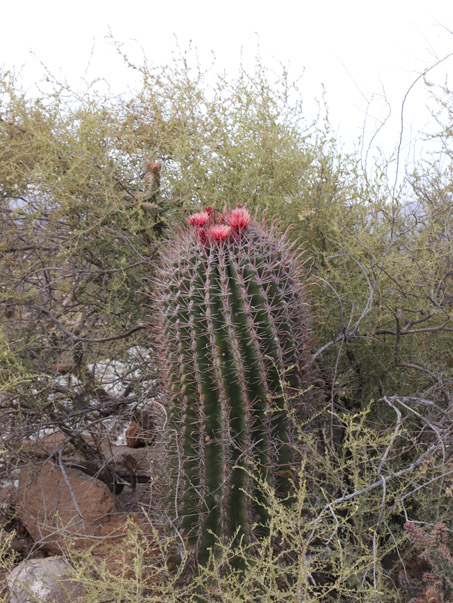
This Peninsular Barrel Cactus was slender and 90 cm tall. We also saw one individual about 1.25 m tall.
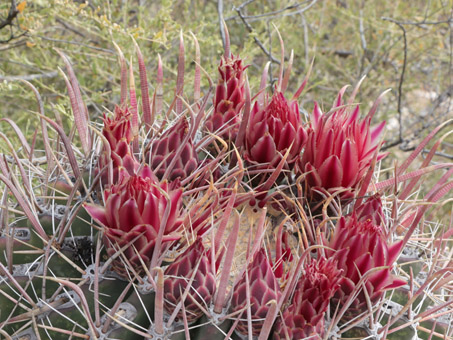
The Peninsular Barrel Cactus has flattened spines that are hooked at the tips. Young spines are often bright red.
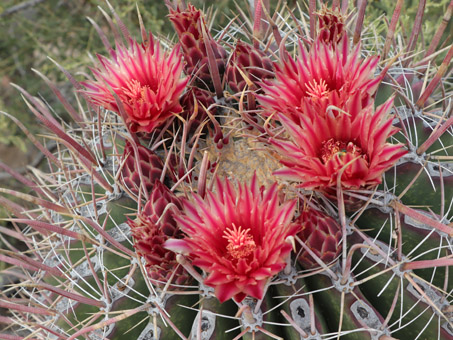
Peninsular Barrel Cactus was the only Barrel Cactus species in bloom and it was doing so spectacularly.

Our second barrel species: Giganta or Straight-Spine Barrel Cactus (Ferocactus rectispinus). This individual was a meter tall and half that in diameter.
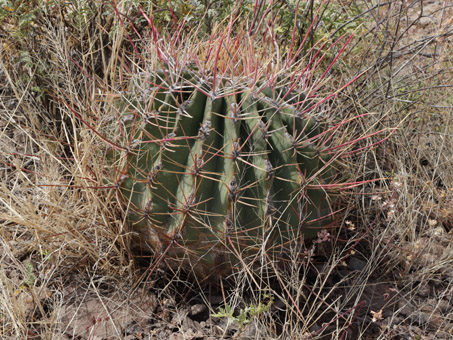
A smaller Giganta barrel individual showing the spines, some as long as 15-20 cm and all lacking the hooked tips.
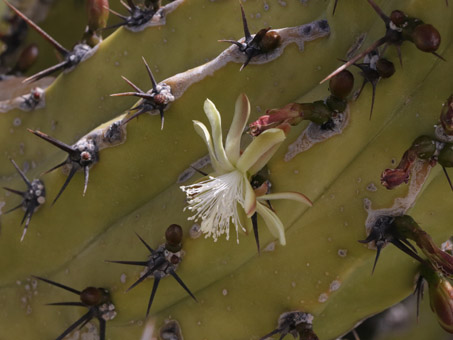
Candelabra Cactus / Cochal (Myrtillocactus cochal). The white flowers open at night for bat and moth pollination.

Cochal flowers will remain open well into the morning when bees are active. There were few open flowers, but many buds.
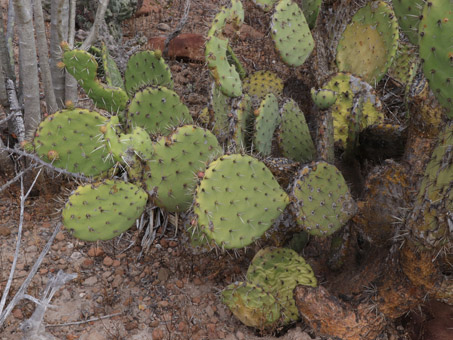
Undetermined species of Prickly Pear (Opuntia sp.).

A flower would help ID this Prickly Pear, but there were only buds
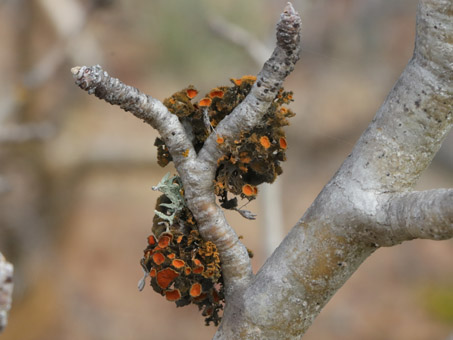
Gold-eye Lichen (Teloschistes chrysophthalmus) on Lomboi. There's also another green-gray fruticose lichen visible.
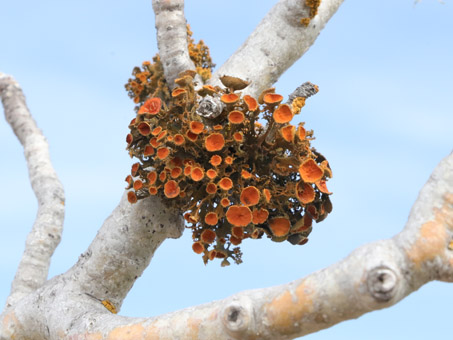
Another Gold-eye lichen on the same shrub.
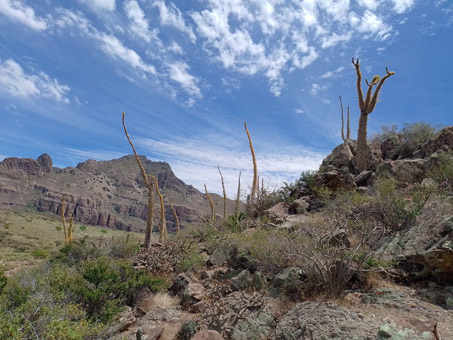
A rocky outcrop we explored a little. The mountain to the left really is tilted, not me! It's kind of disconcerting to look at (see the first photo at the top of the page for a slightly wider view of this scene).
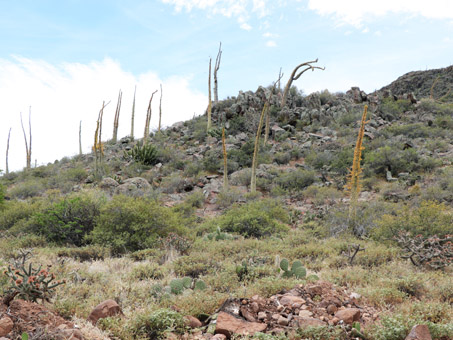
I was so happy that we stopped here. There was such diversity in plants and lichens that couldn't be seen from near the road.
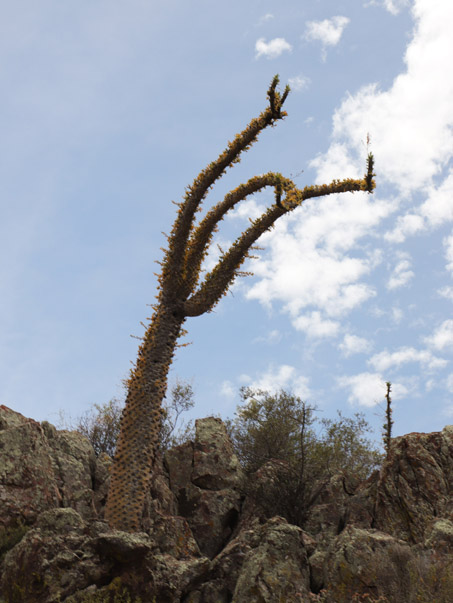
The Boojum Trees / Cirios (Fouquieria columnaris) were in a state of partial undress. This one had not quite lost all of its leaves.
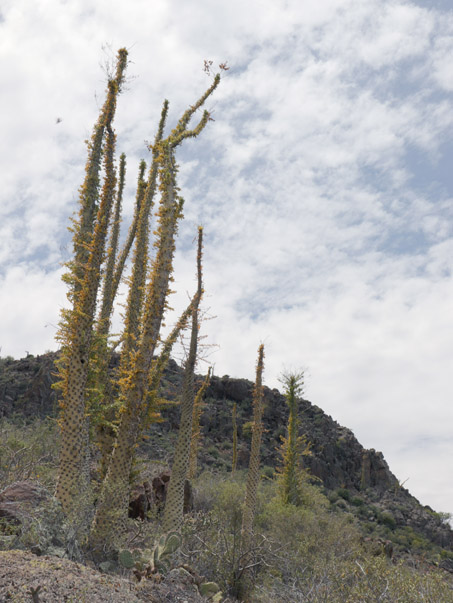
Other Boojums like these still had both live & dying leaves.

Undetermined Shield Lichen (family Parmeliaceae) forming contiguous clusters 30-60 cm L.
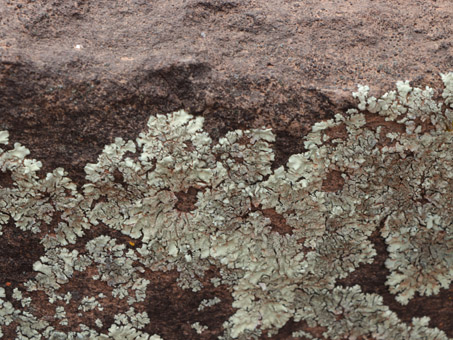
Closeup of the Shield Lichen.

A rocky outcrop with a mixture of lichens, mosses and spike-moss on the ground, in crevices and on the rock faces.
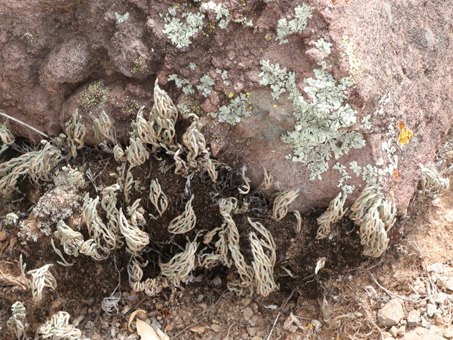
Spike-moss (Selaginella bigelovii) with various moss & lichen species. Limp & gray now, they will spring to life & turn green with water.
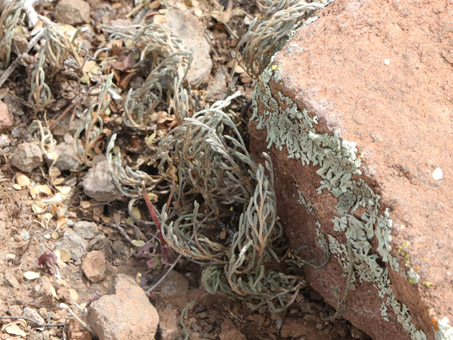
Closeup of the Spike-moss and Shield Lichens.
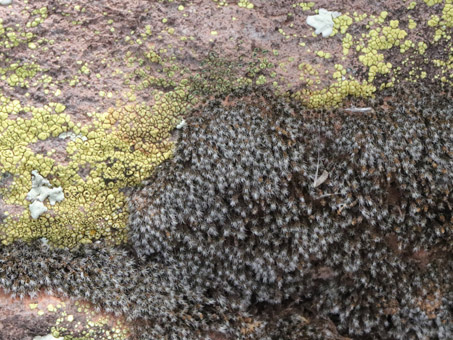
A large (15-30 cm) patch of moss along with a crustose lichen.
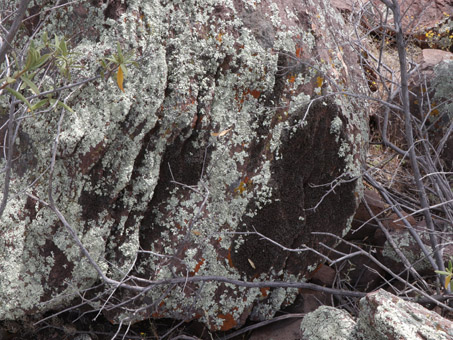
A huge patch of lichens and mosses on a north facing boulder.
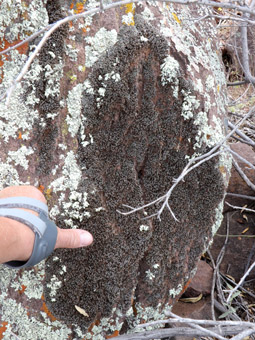
The large, contiguous patch of
moss on a north facing boulder.

Ball moss (Tillandsia recurvata) is not a moss but an epiphyte in the bromeliad family. The main body of the large individual is c. 15 cm D.

The Ball Moss on a lomboy shrub. The long, forked stalks sticking out to left and right are actually its opened seed pods on long stalks.

There were probably thousands of Southern Mountain Phacelia / Rama Zorilla (Phacelia scariosa) growing at roadside & within the scrub.

This a a native Phacelia common throughout much of BCS. It's common Spanish name describes its skunky glandular herbage.
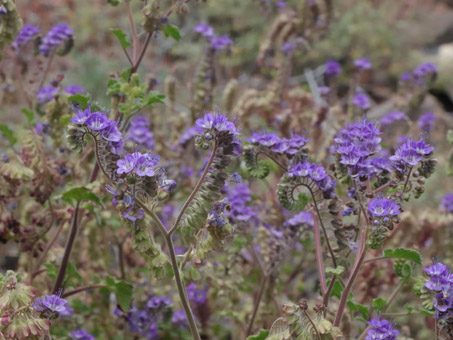
The latin specific epithet refers to the scarious (papery) elongated sepals in the mature fruit (elongation can be seen in this photo).
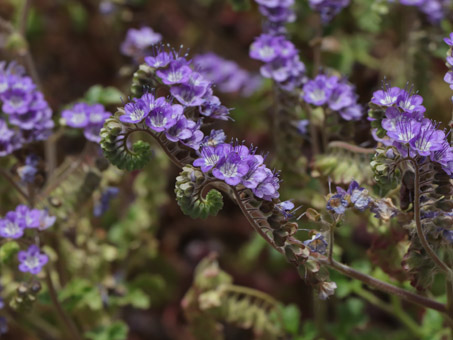
The attractive flowers are 8-10 mm D.
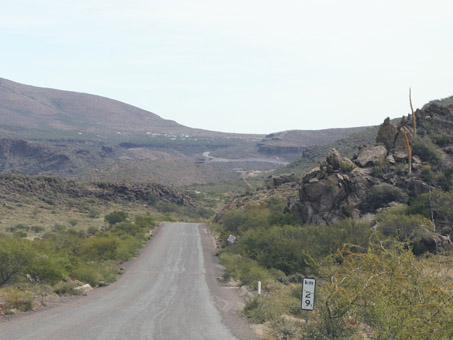
Above the road and spread out just below the skyline is Rancho San Francisco de la Sierra, a small village of related families. Switchbacks that were gouged out of the canyon wall coming up over the hill.
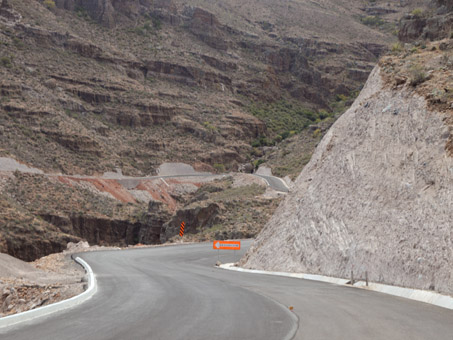
I soon saw that the once white-knuckle, literal cliffhanger of a trip had been reduced to an ordinary country drive. The new pavement had been completed just the day before, according to workers on site.

They dumped tons of rubble down the side of this canyon where there had once been lush growth of native shrubs and trees. Very upsetting.
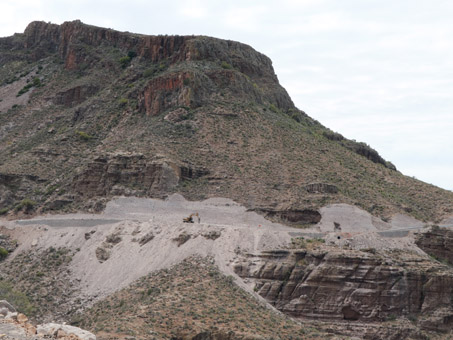
Back across the narrow canyon to the road before the switchback. The beauty & adventure of this section of the canyon is forever gone.
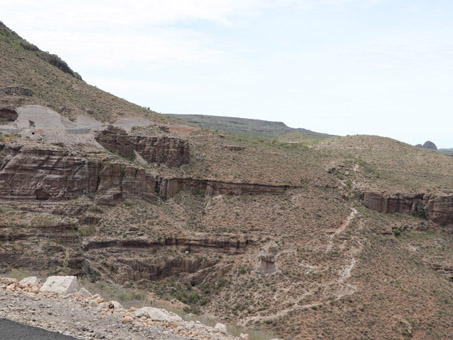
Longer shot...you can see how the canyon just drops off & the debris dumped off the edge. On the R are goat trails down into the canyon.

I found this sign, located in the canyon at one of the switchbacks, to be maddeningly ironic (see below for translation).
"Please respect the trees, rocks and all of nature; they are everyone's heritage and are protected by law. Be a part of conserviing the Sierra's natural heritage. Don't mistreat it nor let others do so..." — government sign
Yeah, tell that to the road contractor. One of my concerns is that like what has happened time and again in small communities on the peninsula, instead of bringing improved economic conditions to this isolated rural area, the Californio traditional way of life on the ranches (already endangered) will be further lost as it becomes packaged and commercialized for easy consumption by a flood of tourists interested only in the next photo op. Only time will tell if opening up the road truly benefits the community. Alright, back to pretty things...

Mexican Blue Oak / Encino Azul (Quercus oblongifolia) is an uncommon evergreen large shrub or small tree (5-8 m tall) with a rounded crown.
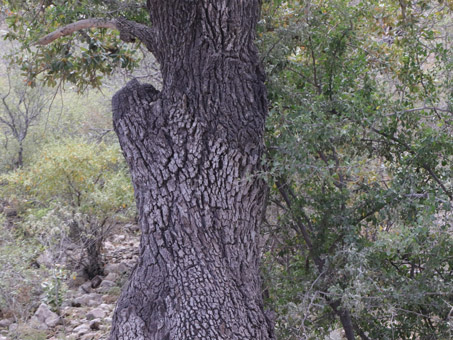
The trunk is up to 50 cm D with light gray, deeply furrowed bark. Leaves are small, leathery, oblong and blue-green.
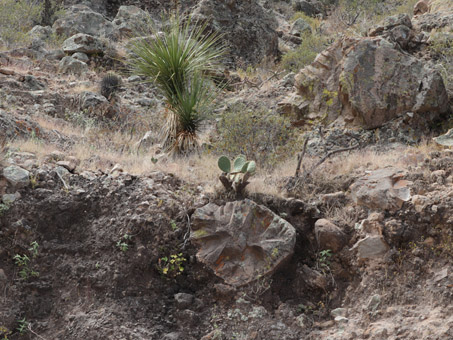
An interesting old road cut in one of the switchbacks that was untouched. Above the center rock is a Nopal and to its right is a small Brandegee Bear-Grass / Sotol (Nolina brandegeei), a native tree-like species in the Ruscaceae family (formerly in the Agave family).
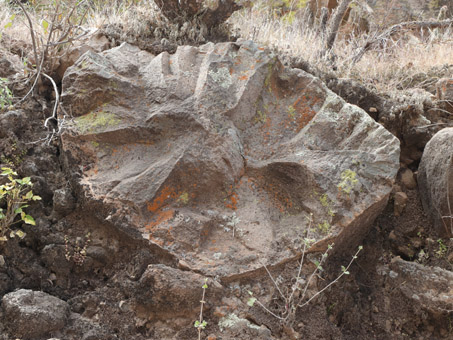
Closeup of the rock with its unusual surface relief. It had orange, yellow and green crustose lichens growing on it.
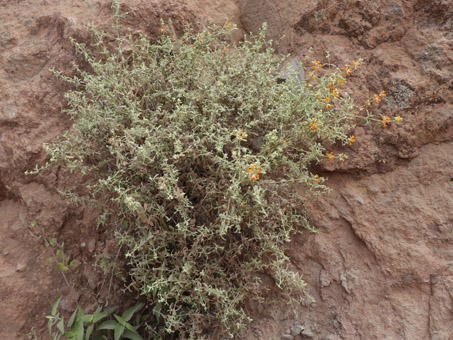
Moran Butterflybush (Buddleja corrugata subsp. moranii, Scrophulariaceae) is a BCS endemic shrub. I photographed the same plant in 2010 when it was only about half this size.
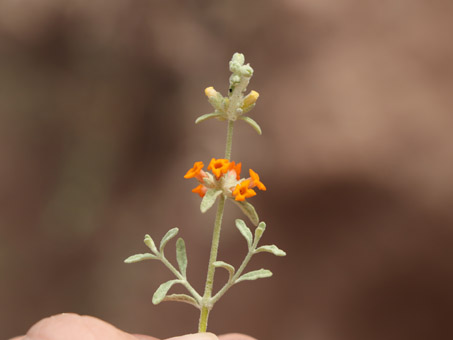
The tubular flowers of Moran Butterflybush are about 5-7 mm D. This plant was growing on a rock and soil arroyo wall.
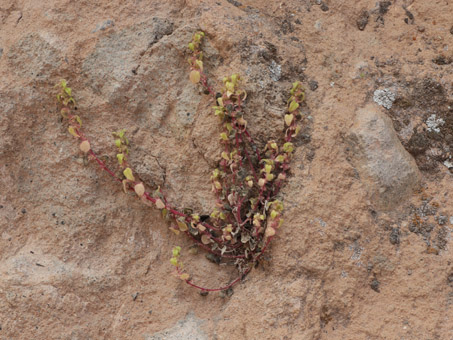
This small Western Pellitory (Parietaria hespera) plant (only about 30 cm H) was growing flat against the arroyo wall.
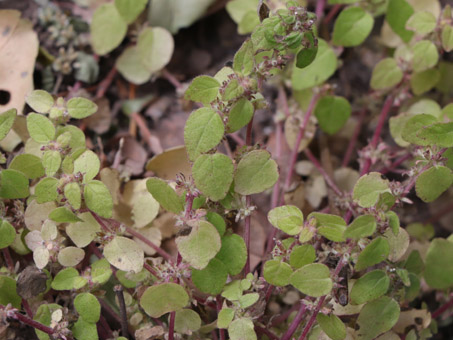
Western Pellitory is in the Nettle family, but the fuzzy herbage is soft & non-stinging, though apparently it does irritate some people.

Peninsular Sage (Salvia peninsularis) is endemic to the peninsula and is generally found at higher elevations. There were no flowers yet, but the plants were lush. Purple tubular flowers grow in long spikes.
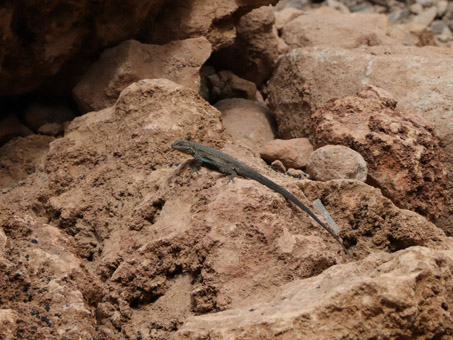
This Baja California Brush Lizard / Cachora de Árbol Cola Negra (Urosaurus nigricauda) continued to sun itself unperturbed as I inched up slowly to snap this image. This is a Mexican endemic.
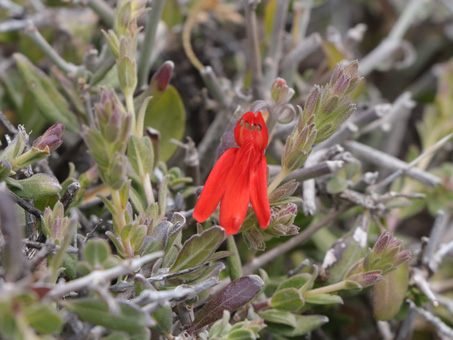
Palmer Tube-Tongue / Ramajo Blanco (Justicia palmeri) is endemic to the peninsula. It occurs from these mountains S to the Cape region.
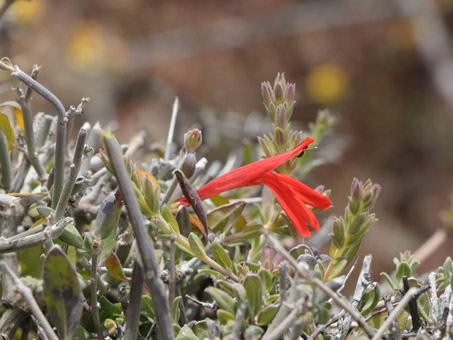
The flowers of Palmer Tube-Tongue are scarlet, two lipped and about 2.5 cm L. The leaves are shorter. The fruit are club-shaped.
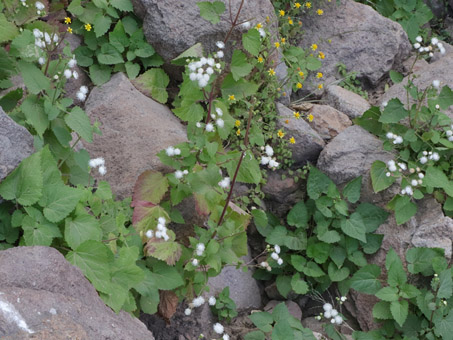
Sticky Snakeroot (Agoseris viscosissima) is another peninsular endemic, found from these mountains S to the Cape region.

Sticky Snakeroot has dense glandular hairs on its herbage. The flower heads are discoid with long white linear style branches.
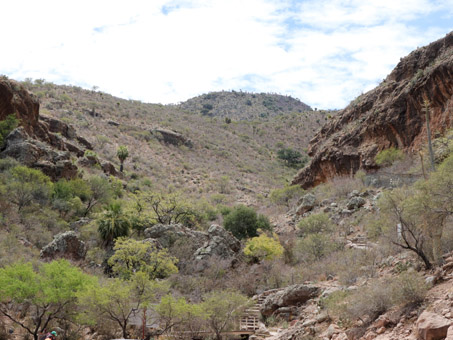
Side canyon at switchback with Cueva Ratón, a rock art site, above R.

Cueva Ratón. It's an easy walk. A fee & a guide with key are required.
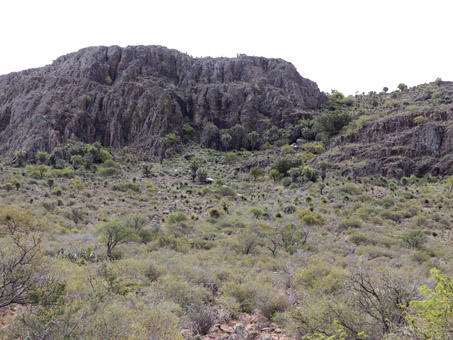
An alluvial fan with dense growth. Unseen is the rock-strewn ground that makes mules the preferred form of cross-country travel.

Same alluvial fan and outcrop. The scale becomes more apparent as the trees start to be recognizable as palms and other large species.
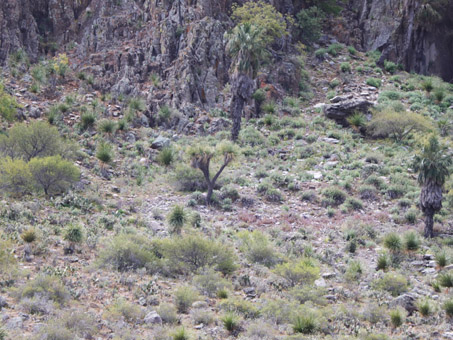
The palms look like the endemic Brandegee Fan Palm / Palma de Tlaco (Brahea brandgeei), seeming to lack the criss-crossed leaf petioles of the Washingtonia palm. Sotol, which looks a lot like Joshua Tree is the forked tree-like individual at center with smaller ones all around.
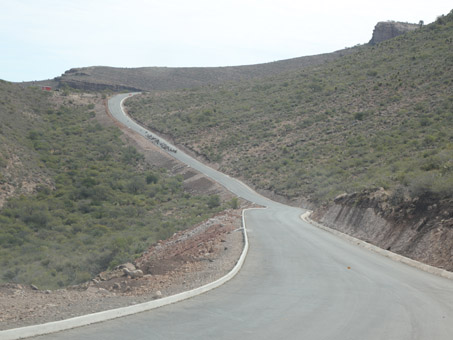
What is that on the road??
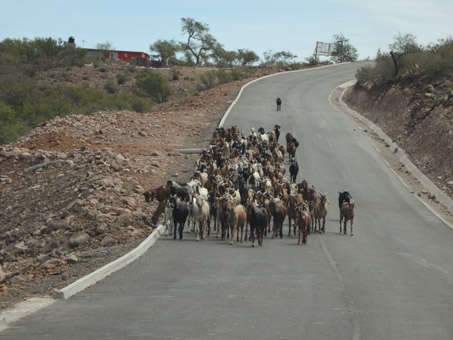
Aha! A herd of goats out for a morning stroll. With the proverbial proverbial (and literal) "black sheep" of the family bringing up the rear.
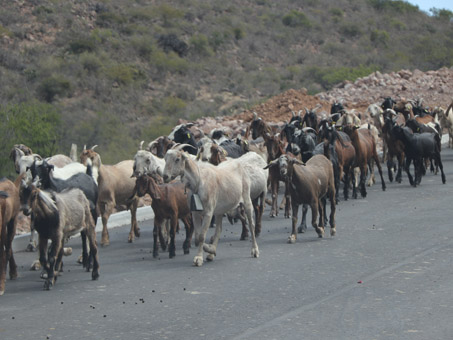
They kindly moved out of our lane as we passed by. On our way back down the mountain, another herd escorted us on our way.
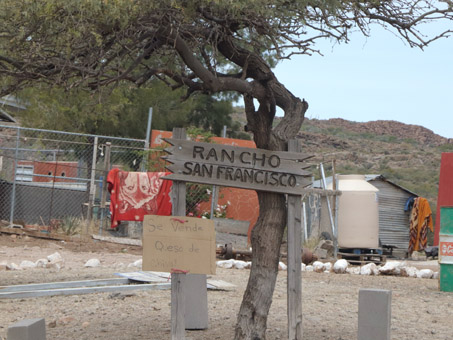
It's safe to say that there are more goats than people in this village.
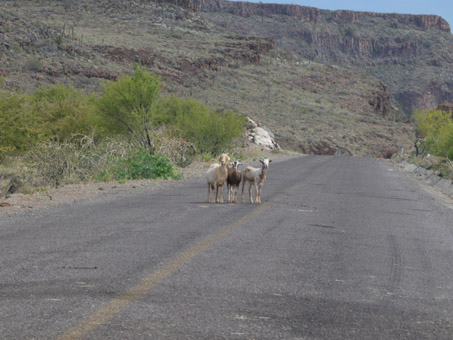
The sierras "ambassadors"? Let's call them "Las Queseras" since they are the source for all the cheese that feeds the local economy.

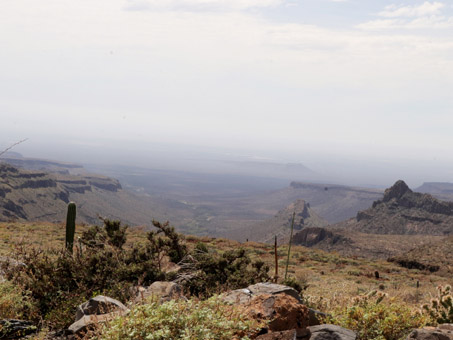
The view as we returned to the Vizcaíno Desert down the west side of the mountains. The light kept changing throughout the day as the cloud cover varied from foggy to overcast to partly cloudy and anywhere in between. The foreground of the image at left shows overgrazing typical in parts of the sierras, but in the distance in both images, the various eroded steps of a cap of volcanic rock can be seen. Below that is old sea bed, the foundation of the Vizcaíno Plain.
As I finish this entry, we´re on the road headed for Baja California, so it's been a quick entry this month. I can't wait to get to Mulegé and head up into the mountains as soon as possible to look for any remaining flowers, mosses and ferns. I'll be sure to share any finds with you. Hasta pronto...!
Debra Valov — Curatorial Volunteer
References and Literature Cited
iNaturalist. Available from https://www.inaturalist.org. (Accessed October 2023)
Rebman, J. P., J. Gibson, and K. Rich, 2016. Annotated checklist of the vascular plants of Baja California, Mexico. Proceedings of the San Diego Society of Natural History, No. 45, 15 November 2016. San Diego Natural History Museum, San Diego, CA. Full text available online.
Rebman, J. P and Roberts, N. C. (2012). Baja California Plant Field Guide. San Diego, CA: Sunbelt Publications. Descriptions and distribution.
Valov, D. (2020). An Annotated Checklist of the Vascular Plants of Mulegé, Baja California, Mexico. Madroño 67(3), 115-160, (23 December 2020). https://doi.org/10.3120/0024-9637-67.3.115
Wiggins, I. L. (1980). The Flora of Baja California. Stanford University Press. Keys and descriptions.









































































